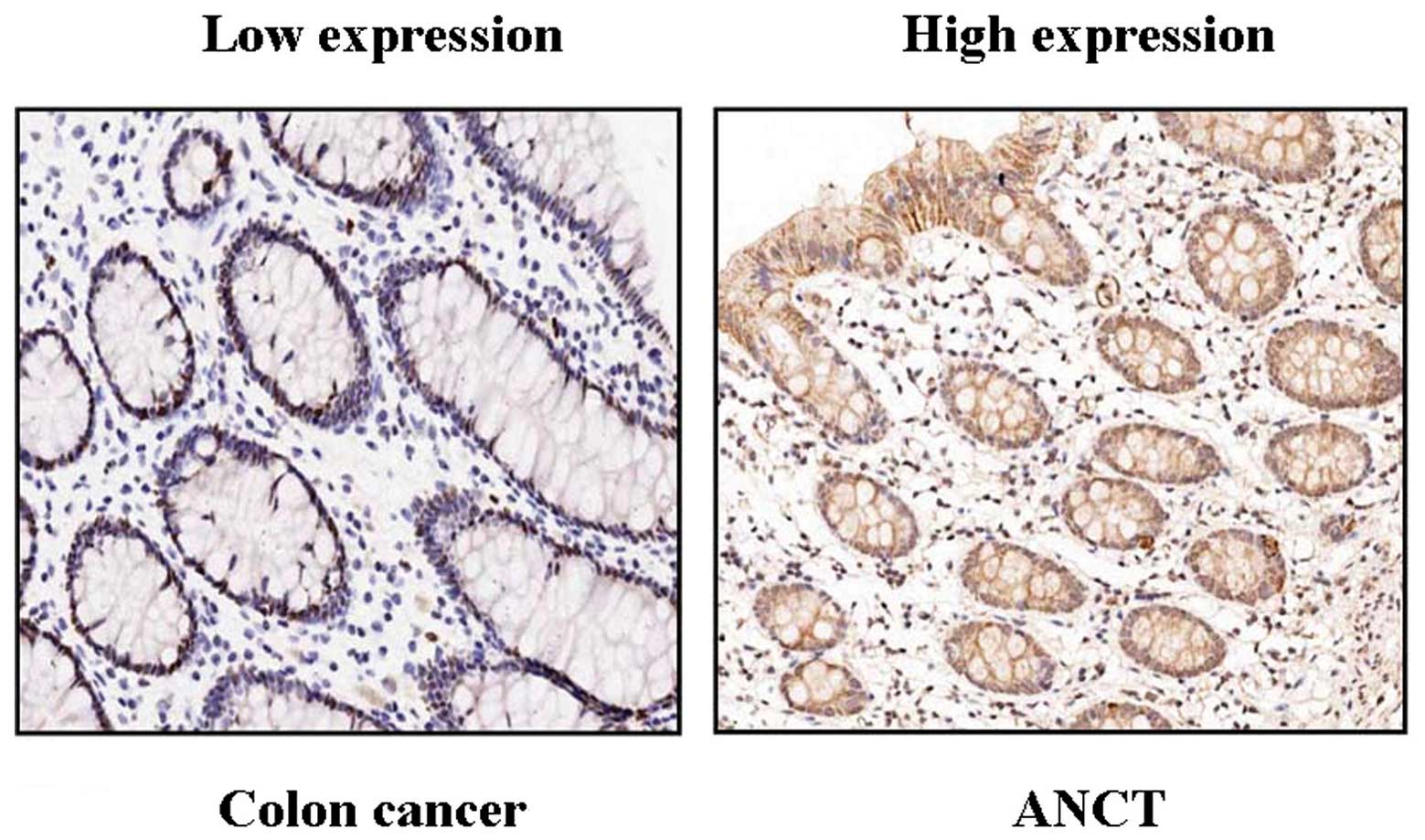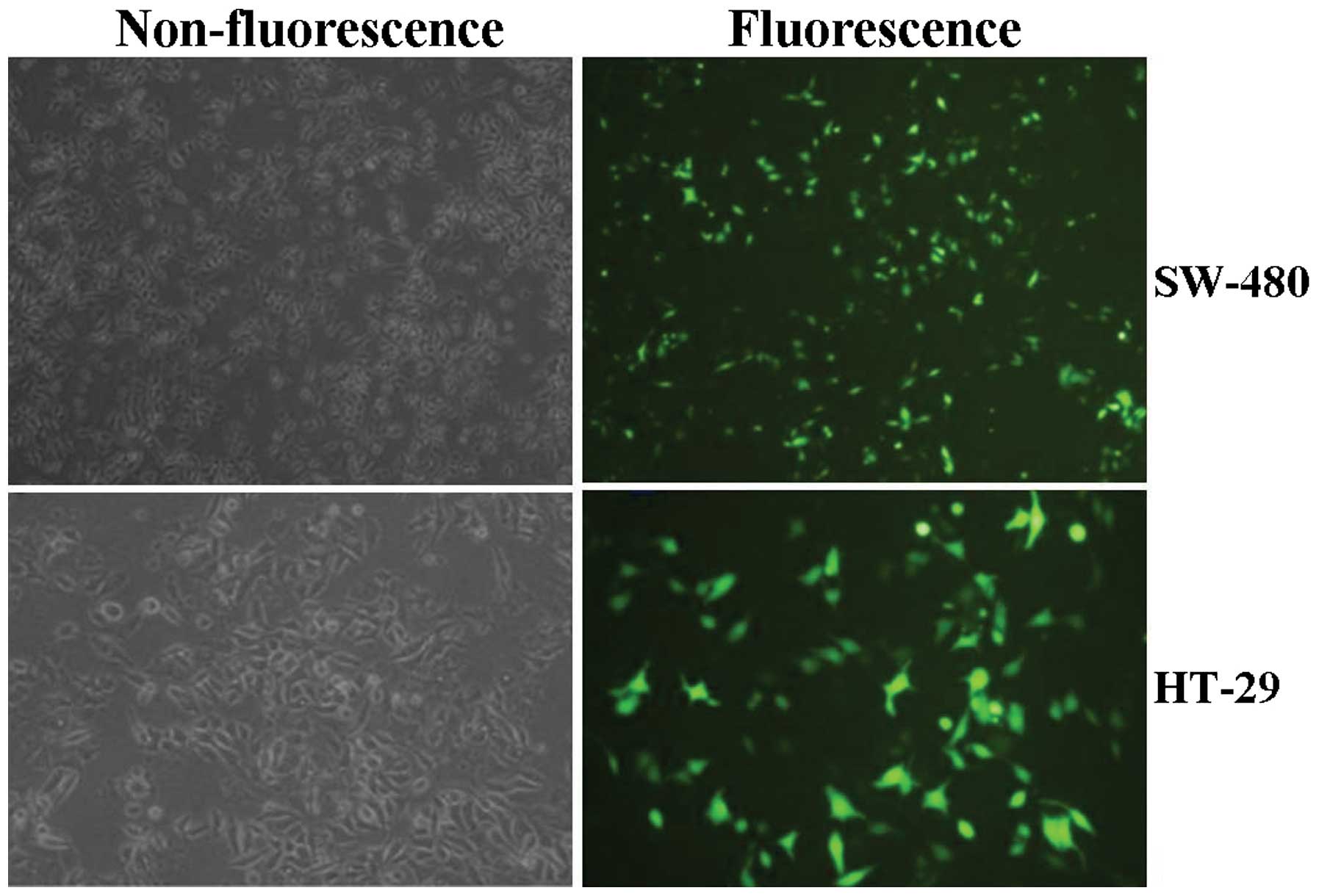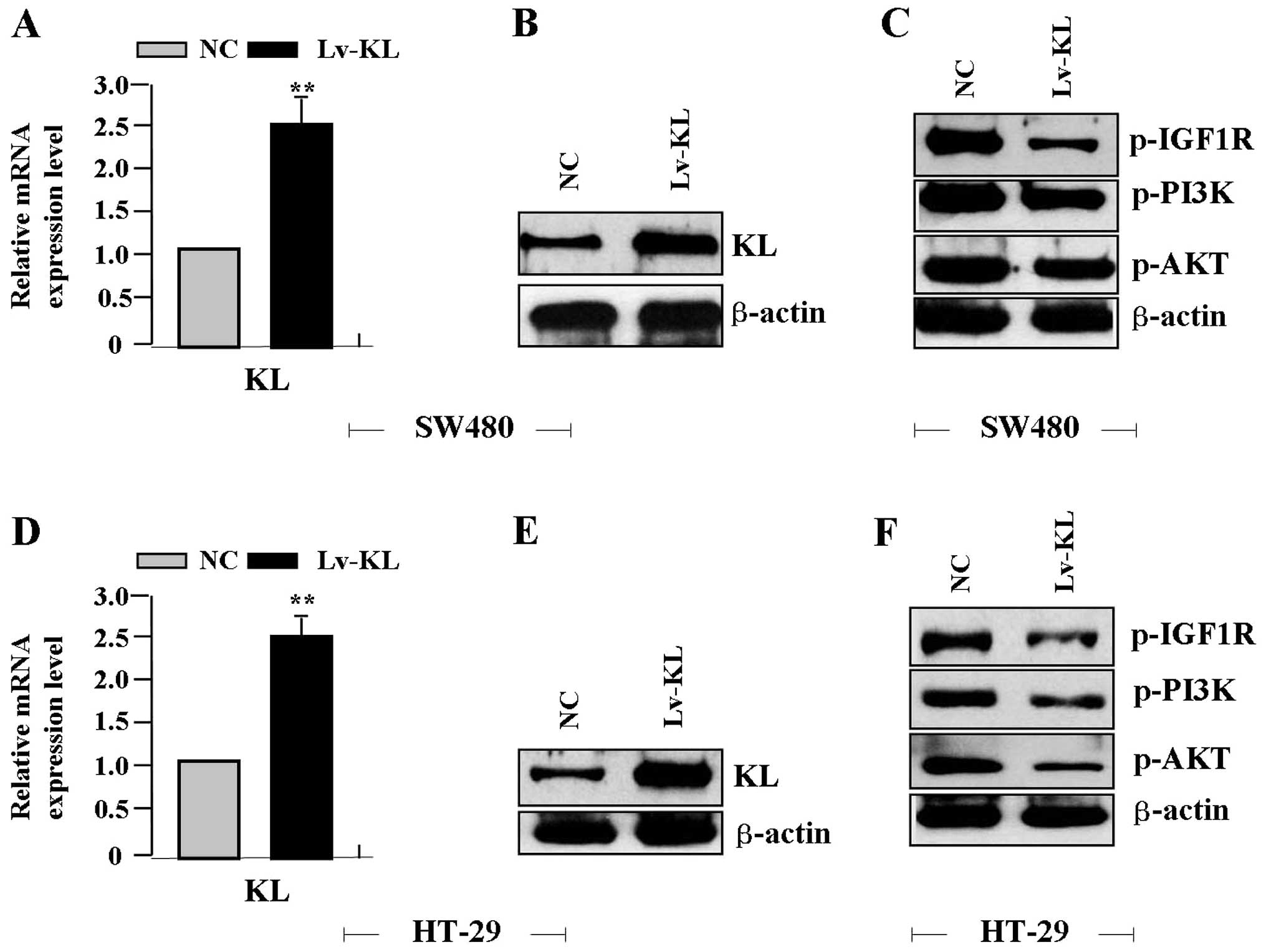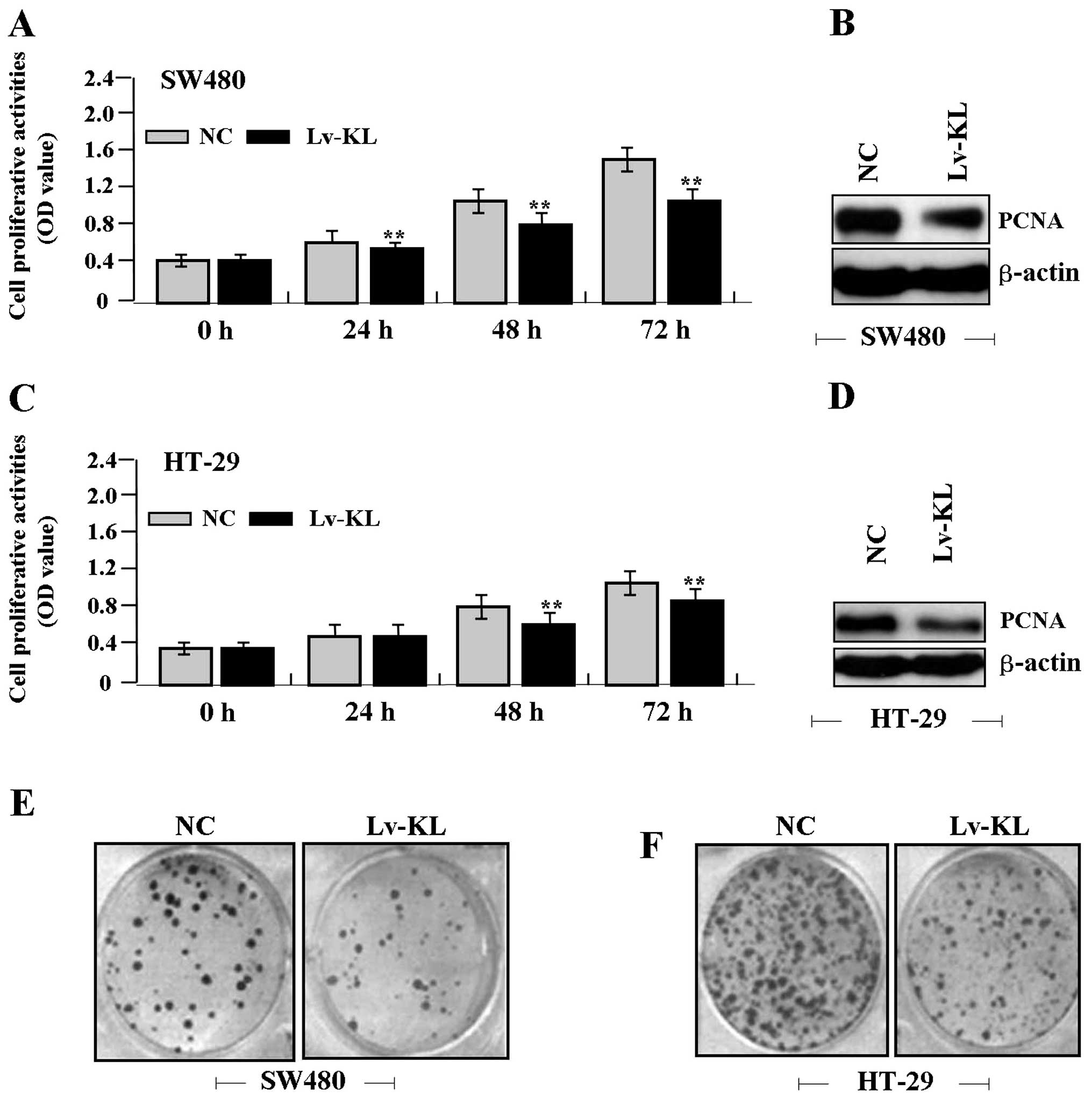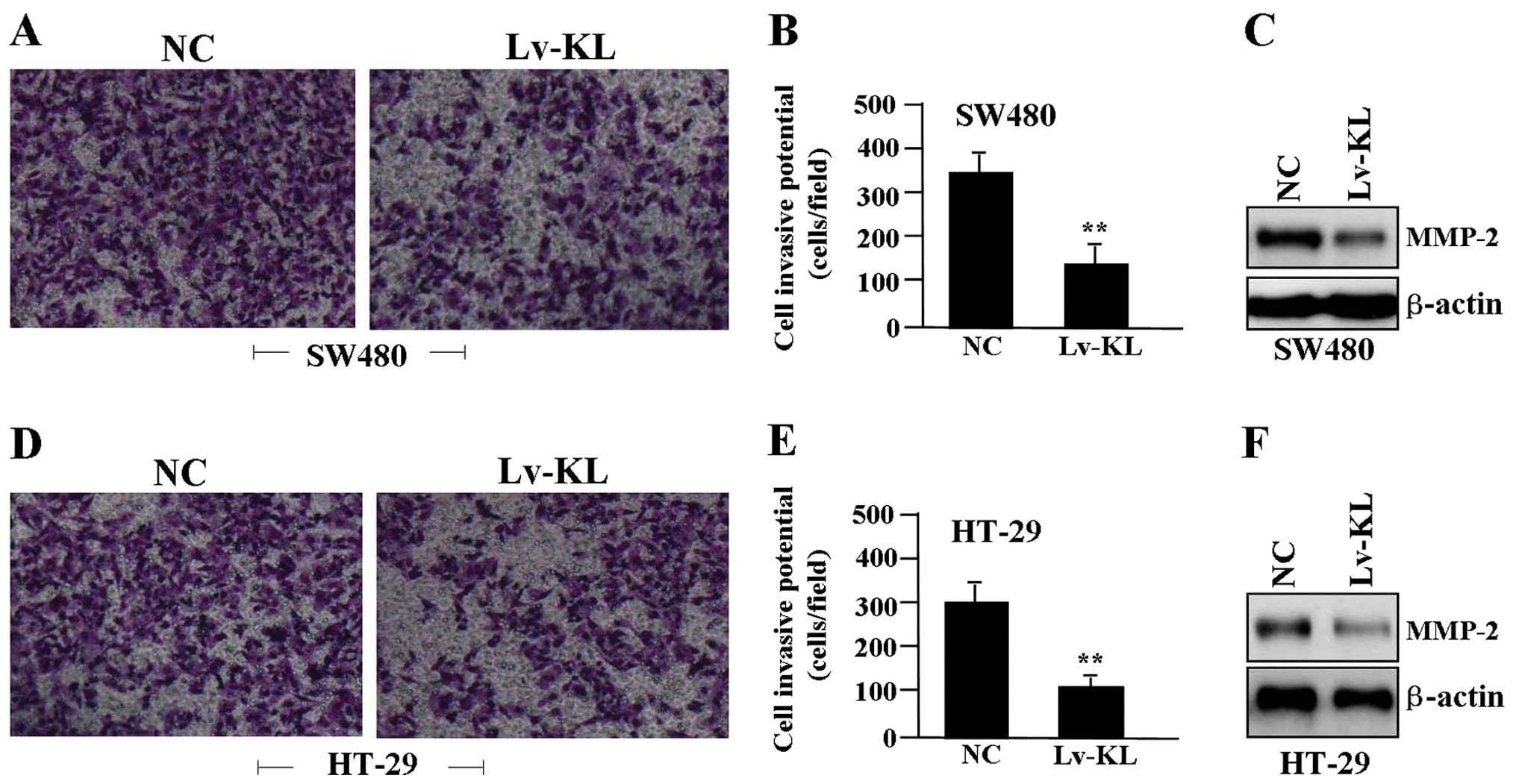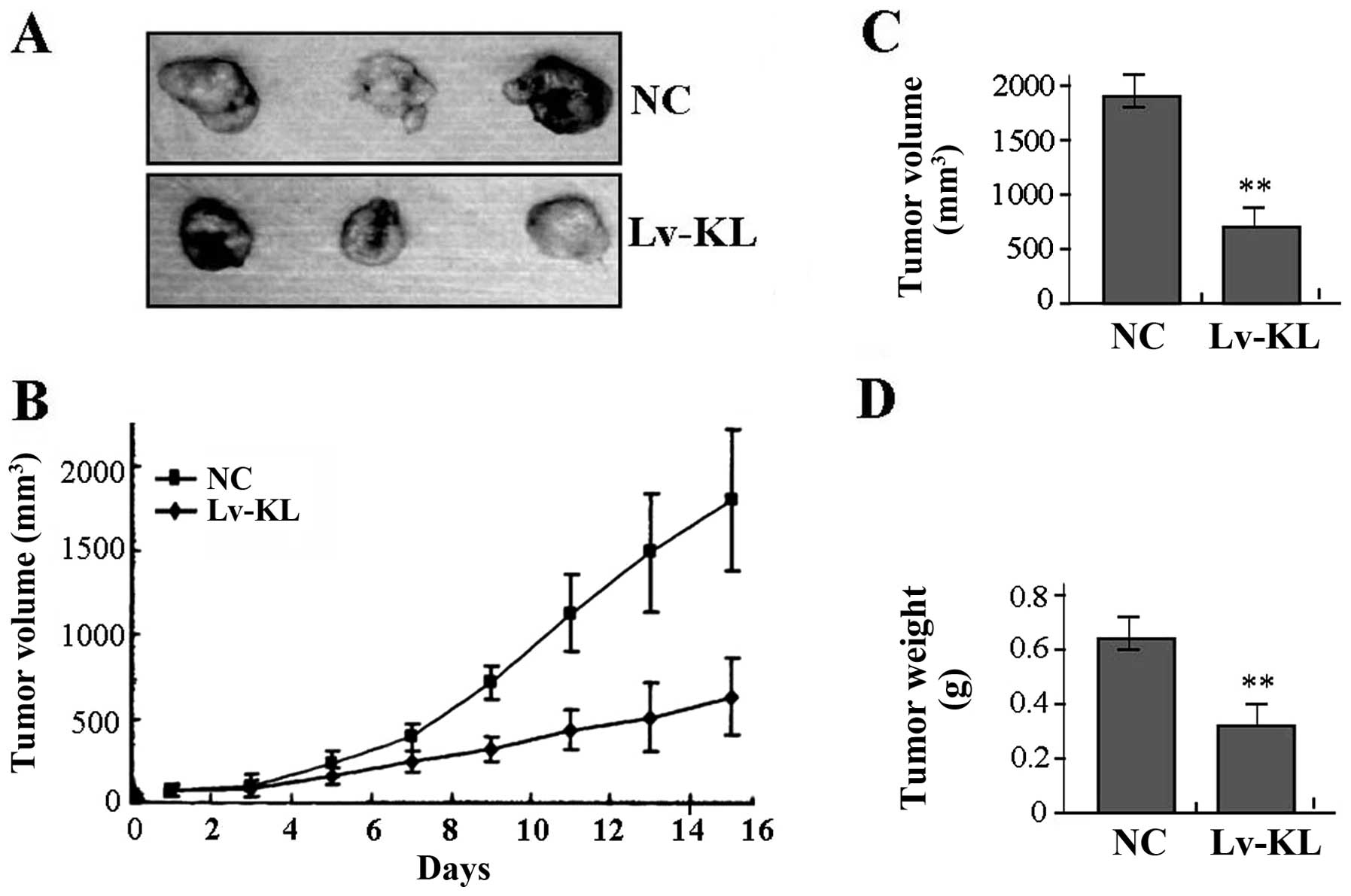Klotho suppresses growth and invasion of colon cancer cells through inhibition of IGF1R-mediated PI3K/AKT pathway
- Authors:
- Published online on: May 9, 2014 https://doi.org/10.3892/ijo.2014.2430
- Pages: 611-618
Abstract
Introduction
Colorectal cancer (CRC) is a major burden to healthcare systems worldwide accounting for approximately one million of new cancer cases (1). The mortality associated with CRC remains high despite advances made in adjuvant and neoadjuvant therapy (2). Search for new and effective anti-cancer treatments is needed and an attractive avenue of research is gene intervention therapy for cancer.
The klotho (KL) gene is a classical ‘aging suppressor’ gene. The role of KL was first demonstrated in the pathology of chronic kidney diseases. The physiological and pathological function of KL shows it can be used as a regulator of oxidative stress and senescence (3). Moreover, recent studies show that KL is involved in the progression of several types of human cancers, and plays an important role in tumorigenesis, proliferation, survival, autophagy and resistance to antitumor therapies (4). KL is inactivated through promoter hypermethylation and potentially functions as a tumor suppressor gene in human cancers (5,6), suggesting loss of KL may serve as an early marker for breast tumorigenesis (7). KL is also decreased in small cell lung cancer (SCLC) and hepatocellular carcinoma (HCC), predictive of a favorable outcome following resection in SCLC and HCC patients (8,9).
The function of KL in cancer is characterized by participating in infiltration and proliferation of cancer cells through multiple signaling pathways. KL suppresses renal fibrosis and cancer metastasis through transforming growth factor (TGF) signaling (10), while loss of KL increases Wnt5A expression and enhances melanoma cell motility (11). KL is downregulated in pancreatic adenocarcinoma, reduces growth of pancreatic cancer cells through inactivation of the IGF-I and the bFGF pathways (12). Overexpression of KL inhibits cell proliferation, motility and invasion, and induces apoptosis in lung and cervical cancers (13–15), suggesting the use of KL as potential strategy for the development of novel therapeutic interventions for cancer.
However, some studies show that KL is highly expressed in ovarian cancer (16) and HCC (17) and is associated with increased risk of disease progression and death (16), but KLB-silencing in HCC cells decreases cell proliferation and suppresses FGFR downstream signaling (17). In order to expound the expression and function of KL in cancer, we investigate the expression of KL in human colon cancer by immunohistochemistry (IHC) assay, and assessed the tumor growth and invasion in colon cancer cells in vitro and in vivo. We hypothesized that overexpression of KL might function as a tumor suppressor in colon cancer.
Materials and methods
Materials
The colon cancer cell lines (SW480 and HT-29) used for experiments were obtained from the Institute of Biochemistry and Cell Biology (Shanghai, China). Lentivirus-mediated KL vector (Lv-KL), negative control vector, and virion-packaging elements were purchased from Genechem (Shanghai, China). Human colon cancer tissues and the corresponding ANCT were collected from Department of Colorectal Surgery of Fudan University. The tissue microarray of colon cancer was made by Shanghai Outdo Biotech Co. Ltd (Shanghai, China). All the antibodies were purchased from Cell Signaling Technologies (Boston, MA, USA). KL primer was synthesized by ABI (Framingham, MA, USA).
Drugs and reagents
Dulbecco’s modified Eagle’s medium (DMEM) and fetal bovine serum (FBS) were purchased from Thermo Fisher Scientific Inc. (Waltham, MA, USA); TRIzol Reagent and Lipofectamine 2000 were obtained from Invitrogen (Carlsbad, CA, USA); M-MLV Reverse Transcriptase was purchased from Promega (Madison, WI, USA); SYBR-Green Master Mix was obtained from Takara (Otsu, Japan); and the ECL Plus Kit was obtained from GE Healthcare (Piscataway, NJ, USA).
Clinical samples and data
Tissue microarray was prepared for IHC. Human colon cancer tissues and the corresponding ANCT were obtained from biopsy in a total of 68 consecutive colon cancer cases admitted in our hospital from January, 2006 to December, 2011. The baseline characteristics of the patients before neo-adjuvant chemotherapy were summarized. The study was approved by Medical Ethics Committee of Fudan University and written informed consent was obtained from the patients or their parents before sample collection. Two pathologists independently reviewed all of the cases.
Tissue microarray
The advanced tissue arrayer (ATA-100, Chemicon International, Tamecula, CA, USA) was used to create holes in a recipient paraffin block and to acquire cylindrical core tissue biopsies with a diameter of 1 mm from the specific areas of the ‘donor’ block. The tissue core biopsies were transferred to the recipient paraffin block at defined array positions. The tissue microarrays contained tissue samples from 68 formalin-fixed paraffin-embedded cancer specimens with known diagnosis, and corresponding ANCT from these patients. The block was incubated at 45°C for 20 min to allow complete embedding of the grafted tissue cylinders in the paraffin of the recipient block, and then stored at 4°C until microtome sectioning.
Immunohistochemical staining
Tissue microarray sections were processed for IHC analysis of KL protein as follows. Immunohistochemical examinations were carried out on 3-mm thick sections. For anti-KL immunohistochemistry, unmasking was performed with 10 mM sodium citrate buffer, pH 6.0, at 90°C for 30 min. For anti-KL immunohistochemistry, antigen unmasking was not necessary. Sections were incubated in 0.03% hydrogen peroxide for 10 min at room temperature, to remove endogenous peroxidase activity, and then in blocking serum (0.04% bovine serum albumin, A2153, Sigma-Aldrich, Shanghai, China; and 0.5% normal goat serum X0907, Dako Corporation, Carpinteria, CA, USA; in PBS) for 30 min at room temperature. Anti-KL antibody was used at a dilution of 1:200. The antibody was incubated overnight at 4°C. Sections were then washed three times for 5 min in PBS. Non-specific staining was blocked with 0.5% casein and 5% normal serum for 30 min at room temperature. Finally, staining was developed using diaminobenzidine substrate, and sections were counterstained with hematoxylin. Normal serum or PBS was used to replace anti-KL antibody in negative controls.
Quantification of protein expression
The expression of KL was semiquantitatively estimated as the total immunostaining scores, which were calculated as the product of a proportion score and an intensity score. The proportion and intensity of the staining was evaluated independently by two observers. The proportion score reflected the fraction of positive staining cells (0, none; 1, ≤10%; 2, 10 to ≤25%; 3, >25 to 50%; 4, >50%), and the intensity score represented the staining intensity (0, no staining; 1, weak; 2, intermediate; and 3, strong). Finally, a total expression score was given ranging from 0 to 12. Based on the analysis in advance, KL expression was categorized into two groups: low-level KL expression (score 0–3) and high-level KL expression (score 4–12). The scoring was independently assessed by two pathologists.
Cell culture and transfection
Colon cancer cell lines were cultured in DMEM medium supplemented with 10% heat-inactivated FBS, 100 U/ml of penicillin, and 100 μg/ml of streptomycin. Cells in this medium were placed in a humidified atmosphere containing 5% CO2 at 37°C. Cells were subcultured at a 1:5 dilution in medium containing 300 μg/ml G418 (an aminoglycoside antibody, commonly used stable transfection reagent in molecular genetic testing). On the day of transduction, colon cancer cells were replated at 5×104 cells/well in 24-well plates containing serum-free growth medium with polybrene (5 mg/ml). When reached 50% confluence, cells were transfected with recombinant experimental virus or control virus at the optimal MOI (multiplicity of infection) of 50, and cultured at 37°C and 5% CO2 for 4 h. Then supernatant was discarded and serum containing growth medium was added. At 4 days of post-transduction, transduction efficiency was measured by the frequency of green fluorescent protein (GFP)-positive cells. Positive and stable transfectants were selected and expanded for further study. The Lv-KL vector-infected clone and the negative control vector-infected cells were named as Lv-KL group and NC group.
Quantitative PCR
To quantitatively determine the mRNA expression level of KL in colon cancer cells, real-time PCR was performed. Total RNA was extracted from each clone using TRIzol according to the manufacturer’s protocol. Reverse transcription was carried out using M-MLV and cDNA amplification was performed using the SYBR-Green master mix kit according to the manufacturer’s guidelines. The KL gene was amplified using a specific oligonucleotide primer and the β-actin gene was used as an endogenous control. Data were analyzed using the comparative Ct method (2−ΔΔCt). Three separate experiments were performed for each clone.
Western blot assay
Colon cancer cell lines were harvested and extracted using lysis buffer (Tris-HCl, SDS, mercaptoethanol and glycerol). Cell extracts were boiled for 5 min in loading buffer, and then an equal amount of cell extract was separated on 15% SDS-PAGE gels. Separated protein bands were transferred onto polyvinylidene fluoride (PVDF) membranes, which were subsequently blocked in 5% skim milk powder. Primary antibodies against KL, p-IGF1R, p-PI3K, p-AKT, PCNA and MMP-2 were diluted according to the manufacturer’s instructions and incubated overnight at 4°C. Subsequently, horseradish peroxidase-linked secondary antibodies were added at a dilution of 1:1,000 and incubated at room temperature for 2 h. The membranes were washed 3 times with PBS, and the immunoreactive bands were visualized using the ECL Plus Kit according to the manufacturer’s instructions. The relative protein levels in different cell lines were normalized to the concentration of β-actin. Three separate experiments were performed for each clone.
Cell proliferation assay
Cell proliferation was analyzed using the MTT assay. Briefly, cells infected with Lv-KL virus were incubated in 96-well-plates at a density of 1×105 cells per well with DMEM medium supplemented with 10% FBS. Cells were treated with 20 μl of MTT dye at 0, 24, 48 and 72 h, and subsequently incubated with 150 μl of DMSO for 5 min. The color reaction was measured at 570 nm using an Enzyme Immunoassay Analyzer (Bio-Rad Laboratories, Hercules, CA, USA). The proliferation activity was calculated for each clone.
Colony formation assay
Colon cancer cells infected with Lv-KL were counted and seeded in 12-well plates (in triplicate) at 100 cells per well. Fresh culture medium was replaced every three days. Colonies were counted only if they contained more than 50 cells, and the number of colonies was counted from the 6th day after seeding and then the cells were stained using crystal violet. The rate of colony formation was calculated with the equation: colony formation rate = (no. of colonies/no. of seeded cells) × 100%.
Transwell invasion assay
Transwell filters were coated with Matrigel (3.9 μg/μl; 60–80 μl) on the upper surface of a polycarbonate membrane (diameter, 6.5 mm; pore size, 8 μm). After incubating at 37°C for 30 min, the Matrigel solidified and served as the extracellular matrix for analysis of tumor cell invasion. Harvested cells (1×105) in 100 μl of serum-free DMEM were added into the upper compartment of the chamber. A total of 200 μl of conditioned medium derived from NIH3T3 cells was used as a source of chemoattractant, which was placed in the bottom compartment of the chamber. After 24 h of incubation at 37°C with 5% CO2, the medium was removed from the upper chamber. The non-invaded cells on the upper side of the chamber were scraped off with a cotton swab. Cells that had migrated from the Matrigel into the pores of the inserted filter were fixed with 100% methanol, stained with hematoxylin, then mounted and dried at 80°C for 30 min. The number of cells invading through the Matrigel was counted in 3 randomly selected visual fields from the central and peripheral portion of the filter by using an inverted microscope (×200 magnification). Each assay was repeated 3 times.
Subcutaneous tumor model and gene therapy
Six-week-old female immune-deficient nude mice (BALB/c-nu) were bred at the laboratory animal facility (Institute of Chinese Academy of Sciences, Shanghai, China), and were housed individually in microisolator ventilated cages with free access to water and food. All experimental procedures were performed according to the regulations and internal biosafety and bioethics guidelines of Fudan University and the Shanghai Municipal Science and Technology Commission. Three mice were injected subcutaneously with 1×108 colon cancer cells (HT-29) in 50 μl of PBS pre-mixed with an equal volume of matrigel matrix (Becton-Dickinson). Mice were monitored daily for development a subcutaneous tumor. When the tumor size reached approximately 5 mm in length, they were surgically removed, cut into 1–2 mm3 pieces, and re-seeded individually into other mice. When tumor size reached approximately 5 mm in length, the mice were randomly assigned as NC group and Lv-KL group. In the treatment group, 15 μl of Lv-KL was injected into subcutaneous tumors using a multi-site injection format. Injections were repeated every other day after initial treatment. The tumor volume every three days was measured with a caliper, using the formula volume = (length × width)2/2.
Statistical analysis
SPSS 20.0 was used for the statistical analysis. Kruskal-Wallis H test and χ2 test were used to analyze the expression rate in all groups. One-way analysis of variance (ANOVA) was used to analyze the differences between groups. The LSD method of multiple comparisons was employed when the probability for ANOVA was statistically significant. Statistical significance was set at P<0.05.
Results
The expression of KL in colon cancer tissues
The expression of KL protein was evaluated using IHC staining in colon cancer tissues. As shown in Fig. 1, different levels of positive expression of KL protein were detected in colon cancer and ANCT tissues. Positive KL immunostaining was mainly localized in the cytoplasm of colon cancer tissue cells. According to the KL immunoreactive intensity, the positive expression of KL in colon cancer tissues was significantly decreased compared with that in ANCT (P<0.001) (Table I).
Correlation of KL expression with clinicopathological parameters
According to the KL immunoreactive intensity, 27 (39.71%) patients were classified as KL-negative group, and 41 (60.29%) patients were classified as KL-positive group. We then analyzed the association between KL expression and the clinicopathological data of patients with colon cancer. As summarized in Table II, we found that decreased expression of KL was closely correlated with the Dukes staging (P=0.034) and invasive depth of colon cancer (P=0.008), but did not relate with the other clinicopathological factors including age, gender, tumor size, degree of differentiation and CEA level (each P>0.05).
Table IIAssociation between KL expression and clinicopathological characteristics of patients with colon cancer. |
The effect of KL overexpression on the expression of IGF1R, PI3K and AKT
First, lentiviruses of different multiplicity of infection (MOI) were used to transfect into colon cancer cell lines (SW480 and HT-29), and the transfection efficiency of Lv-KL (MOI=50), observed by fluorescence microscopy was high, reaching more than 70% (Fig. 2). Then Lv-KL (MOI=50) was transfected into colon cancer cell lines for 24 h, the expression levels of KL mRNA (Fig. 3A and D) and protein (Fig. 3B and E), p-IGF1R, p-PI3K and p-AKT proteins (Fig. 3C and F) were detected by real-time PCR and western blot assays, indicating an obvious increase of KL expression, but a significant decrease of p-IGF1R, p-PI3K and p-AKT expression in Lv-KL group compared with the NC group.
The effect of KL overexpression on cell proliferation and independent growth
Deregulated cell proliferation is a hallmark of cancer (18). To verify the effect of KL overexpression on tumor growth in colon cancer cells, we examined cell proliferative activities by MTT and colony formation assays. The results showed that KL overexpression markedly diminished the proliferative activities of colon cancer cells in a time-dependent manner compared to the NC group (Fig. 4A and C). Colony formation rate of cancer cells was markedly lower in Lv-KL group than the NC group (Fig. 4E and F). In addition, the expression level of PCNA protein, examined by western blot assay (Fig. 4B and D), was significantly downregulated in Lv-KL group compared with the NC group.
The effect of KL overexpression on cell invasion
To determine the effect of KL overexpression on cell invasion, a Transwell assay was performed. The invasive potential of tumor cells in Transwell assay was determined by the ability of cells to invade a matrix barrier containing laminin and type IV collagen, the major components of the basement membrane. Representative micrographs of Transwell filters can be seen in Fig. 5A and D. We found that the invasive potential of colon cancer cells was apparently decreased in Lv-KL group compared to NC group (P<0.01) (Fig. 5B and E). In addition, the expression level of MMP-2 protein, examined by western blot assay (Fig. 5C and F), was significantly downregulated in Lv-KL group compared with the NC group.
The effect of KL overexpression on xenograft tumor growth
Our in vitro experiments demonstrated the inhibitory effect of KL overexpression on tumor growth of colon cancer cells. Therefore, it was necessary to further investigate the effect of KL overexpression on xenograft tumor growth in vivo. The mean volume of tumors in the experimental mice before treatment was 71.45±19.33 mm3. During the whole tumor growth period, the tumor growth activity was measured. The tumors treated with Lv-KL grew substantially slower compared to the NC group (Fig. 6A and B). When the tumors were harvested, the average weight and volume of the tumors in Lv-KL group were significantly smaller than those of the NC group (Fig. 6C and D), suggesting that KL overexpression could suppress growth of colon cancer cells.
Discussion
The KL gene was originally identified as a putative aging-suppressor gene in mice and supplementation of KL can be a novel therapeutic strategy for many age-related diseases (19). KL is expressed most abundantly in the liver, followed by the small intestine, colon, spleen and kidney tissues, and especially the expression of KL in tumors is lower than that in non-tumor regions, suggesting loss of KL expression may be linked to the malignant formation in certain cancers (20). Though few studies indicate KL as the tumor-promoting factor (16), more evidence supports that decreased expression of KL is significantly associated with a good outcome of resected carcinoma patients (21). Our present study and Pan et al (6) demonstrated that KL was markedly downregulated in the cytoplasm of colon cancer tissues when compared to the adjacent non-tumor tissues, and negatively associated with Dukes staging and tumor invasion, suggesting that loss of KL might represent a new biomarker involved in the development of colon cancer.
Overexpression of KL not only functions as an ‘aging suppressor’, but also regulates cell survival and proliferation, and serves as a potential tumor suppressor implicated in cancer metastasis (22). Exogenous KL gene expression significantly inhibits cell growth and invasion, and induces cell apoptosis and autophagy in HCC (23–25). Inversely, some studies have revealed a novel oncogenic function of KL of in promoting tumor migration and invasion via activation of VEGFR2/PAK1 signaling (26). Thus, to further clarify the role of KL in cancer, we assessed the function of KL on its the biological behavior in colon cancer cells, and found that overexpression of KL suppressed growth and invasion of colon cancer cells in vitro and in vivo, indicating that KL might play an important role in the development of colon cancer.
Furthermore, a few studies have focused on the molecular regulatory mechanisms of KL in cancer. KL participates in the progression of several types of human cancers, and functions as a tumor suppressor by inhibiting multiple pathways including insulin/IGF1, p53/p21 and Wnt signaling pathways (4). In addition, it is shown that KL can inhibit epithelial-mesenchymal transition and tumor migration and invasion, and improve the resistance of cancer cells to cisplatin based chemotherapy through inhibition of the PI3K/Akt/GSK3β/Snail pathway in renal cell carcinoma and lung cancer (27,28). IGF1R simulates colon cancer cell growth via activation of the PI3K/AKT pathway (29). Our present study also demonstrated that overexpression of KL could downregulate the expression of IGF1R, p-PI3K and p-AKT in colon cancer cells, suggesting that KL might regulate IGF1R and subsequently activate the downstream PI3K/Akt signaling pathway (23,25).
PCNA is a nuclear protein expressed in proliferating cells and may be required for maintaining cell proliferation, used as a marker for cell proliferation of colon cancer (30). MMP-2 is thought to be a key enzyme involved in the degradation of type IV collagen and high level of MMP-2 in tissues is associated with tumor invasion and metastasis (31). It has been reported that blockade of PI3K/AKT pathway inhibits growth and metastasis of malignant tumor cells via inhibition of PCNA and MMP-2 expression (32). Moreover, in our study, it was found that overexpression of KL downregulated the expression of IGF1R, p-PI3K, p-AKT, PCNA and MMP-2 in colon cancer cells, suggesting that overexpression of KL might inhibit growth and invasions of colon cancer cells through IGF1R/PI3K/AKT pathway-mediated regulation of PCNA and MMP-2 expression.
In conclusion, our findings indicate that KL is downregulated in human colon caner and correlates with tumor invasion, while overexpression of KL blocks growth and invasion of colon cancer cells through inhibition of IGF1R-mediated PI3K/AKT pathway, suggesting that KL may serve as a potential therapeutic target for the treatment of colon cancer.
References
|
Antonic V, Stojadinovic A, Kester KE, et al: Significance of infectious agents in colorectal cancer development. J Cancer. 4:227–240. 2013. View Article : Google Scholar | |
|
Young PE and Womeldorph CM: Colonoscopy for colorectal cancer screening. J Cancer. 4:217–226. 2013. View Article : Google Scholar : PubMed/NCBI | |
|
Kuro-o M: Klotho as a regulator of oxidative stress and senescence. Biol Chem. 38:233–241. 2008. | |
|
Xie B, Chen J, Liu B, et al: Klotho acts as a tumor suppressor in cancers. Pathol Oncol Res. 19:611–617. 2013. View Article : Google Scholar : PubMed/NCBI | |
|
Wang L, Wang X, Wang X, et al: Klotho is silenced through promoter hypermethylation in gastric cancer. Am J Cancer Res. 1:111–119. 2011.PubMed/NCBI | |
|
Pan J, Zhong J, Gan LH, et al: Klotho, an anti-senescence related gene, is frequently inactivated through promoter hypermethylation in colorectal cancer. Tumour Biol. 32:729–735. 2011. View Article : Google Scholar : PubMed/NCBI | |
|
Rubinek T, Shulman M, Israeli S, et al: Epigenetic silencing of the tumor suppressor klotho in human breast cancer. Breast Cancer Res Treat. 133:649–657. 2012. View Article : Google Scholar : PubMed/NCBI | |
|
Usuda J, Ichinose S, Ishizumi T, et al: Klotho predicts good clinical outcome in patients with limited-disease small cell lung cancer who received surgery. Lung Cancer. 74:332–337. 2011. View Article : Google Scholar | |
|
Xie B, Zhou J, Yuan L, et al: Epigenetic silencing of Klotho expression correlates with poor prognosis of human hepatocellular carcinoma. Hum Pathol. 44:795–801. 2013. View Article : Google Scholar : PubMed/NCBI | |
|
Doi S, Zou Y, Togao O, et al: Klotho inhibits transforming growth factor-beta1 (TGF-beta1) signaling and suppresses renal fibrosis and cancer metastasis in mice. J Biol Chem. 286:8655–8665. 2011. View Article : Google Scholar : PubMed/NCBI | |
|
Camilli TC, Xu M, O’Connell MP, et al: Loss of Klotho during melanoma progression leads to increased filamin cleavage, increased Wnt5A expression, and enhanced melanoma cell motility. Pigment Cell Melanoma Res. 24:175–186. 2011. View Article : Google Scholar : PubMed/NCBI | |
|
Abramovitz L, Rubinek T, Ligumsky H, et al: KL1 internal repeat mediates klotho tumor suppressor activities and inhibits bFGF and IGF-I signaling in pancreatic cancer. Clin Cancer Res. 17:4254–4266. 2011. View Article : Google Scholar : PubMed/NCBI | |
|
Chen B, Ma X, Liu S, et al: Inhibition of lung cancer cells growth, motility and induction of apoptosis by Klotho, a novel secreted Wnt antagonist, in a dose-dependent manner. Cancer Biol Ther. 13:1221–1228. 2012. View Article : Google Scholar : PubMed/NCBI | |
|
Chen B, Wang X, Zhao W, et al: Klotho inhibits growth and promotes apoptosis in human lung cancer cell line A549. J Exp Clin Cancer Res. 29:992010. View Article : Google Scholar : PubMed/NCBI | |
|
Chang B, Kim J, Jeong D, et al: Klotho inhibits the capacity of cell migration and invasion in cervical cancer. Oncol Rep. 28:1022–1028. 2012.PubMed/NCBI | |
|
Lu L, Katsaros D, Wiley A, et al: Klotho expression in epithelial ovarian cancer and its association with insulin-like growth factors and disease progression. Cancer Invest. 26:185–192. 2008. View Article : Google Scholar : PubMed/NCBI | |
|
Poh W, Wong W, Ong H, et al: Klotho-beta overexpression as a novel target for suppressing proliferation and fibroblast growth factor receptor-4 signaling in hepatocellular carcinoma. Mol Cancer. 11:142012. View Article : Google Scholar : PubMed/NCBI | |
|
Hanahan D and Weinberg RA: The hallmarks of cancer: the next generation. Cell. 144:646–674. 2011. View Article : Google Scholar : PubMed/NCBI | |
|
Kuro-o M: Klotho in health and disease. Curr Opin Nephrol Hypertens. 21:362–368. 2012. View Article : Google Scholar | |
|
Yahata K, Mori K, Arai H, et al: Molecular cloning and expression of a novel klotho-related protein. J Mol Med (Berl). 78:389–394. 2000. View Article : Google Scholar : PubMed/NCBI | |
|
Usuda J, Ichinose S, Ishizumi T, et al: Klotho is a novel biomarker for good survival in resected large cell neuroendocrine carcinoma of the lung. Lung Cancer. 72:355–359. 2011. View Article : Google Scholar : PubMed/NCBI | |
|
Dërmaku-Sopjani M, Kolgeci S, Abazi S, et al: Significance of the anti-aging protein Klotho. Mol Membr Biol. 30:369–385. 2013. | |
|
Shu G, Xie B, Ren F, et al: Restoration of klotho expression induces apoptosis and autophagy in hepatocellular carcinoma cells. Cell Oncol (Dordr). 36:121–129. 2013. View Article : Google Scholar : PubMed/NCBI | |
|
Ye X, Guo Y, Zhang Q, et al: βKlotho suppresses tumor growth in hepatocellular carcinoma by regulating Akt/GSK-3β/cyclin D1 signaling pathway. PLoS One. 8:e556152013. | |
|
Xie B, Zhou J, Shu G, et al: Restoration of klotho gene expression induces apoptosis and autophagy in gastric cancer cells: tumor suppressive role of klotho in gastric cancer. Cancer Cell Int. 13:182013. View Article : Google Scholar : PubMed/NCBI | |
|
Chen L, Liu H, Liu J, et al: Klotho endows hepatoma cells with resistance to anoikis via VEGFR2/PAK1 activation in hepatocellular carcinoma. PLoS One. 8:e584132013. View Article : Google Scholar : PubMed/NCBI | |
|
Zhu Y, Xu L, Zhang J, et al: Klotho suppresses tumor progression via inhibiting PI3K/Akt/GSK3β/Snail signaling in renal cell carcinoma. Cancer Sci. 104:663–671. 2013.PubMed/NCBI | |
|
Wang Y, Chen L, Huang G, et al: Klotho sensitizes human lung cancer cell line to cisplatin via PI3k/Akt pathway. PLoS One. 8:e573912013. View Article : Google Scholar : PubMed/NCBI | |
|
do Lim Y, Cho HJ, Kim J, et al: Luteolin decreases IGF-II production and downregulates insulin-like growth factor-I receptor signaling in HT-29 human colon cancer cells. BMC Gastroenterol. 12:92012.PubMed/NCBI | |
|
Risio M: Cell proliferation in colorectal tumor progression: an immunohistochemical approach to intermediate biomarkers. J Cell Biochem (Suppl). 16G:79–87. 1992. View Article : Google Scholar : PubMed/NCBI | |
|
Liabakk NB, Talbot I, Smith RA, et al: Matrix metalloproteinase 2 (MMP-2) and matrix metalloproteinase 9 (MMP-9) type IV collagenases in colorectal cancer. Cancer Res. 56:190–196. 1996. | |
|
Fu Y, Zhang Q, Kang C, et al: Inhibitory effects of adenovirus mediated Akt1 and PIK3R1 shRNA on the growth of malignant tumor cells in vitro and in vivo. Cancer Biol Ther. 8:1002–1009. 2009. View Article : Google Scholar |



